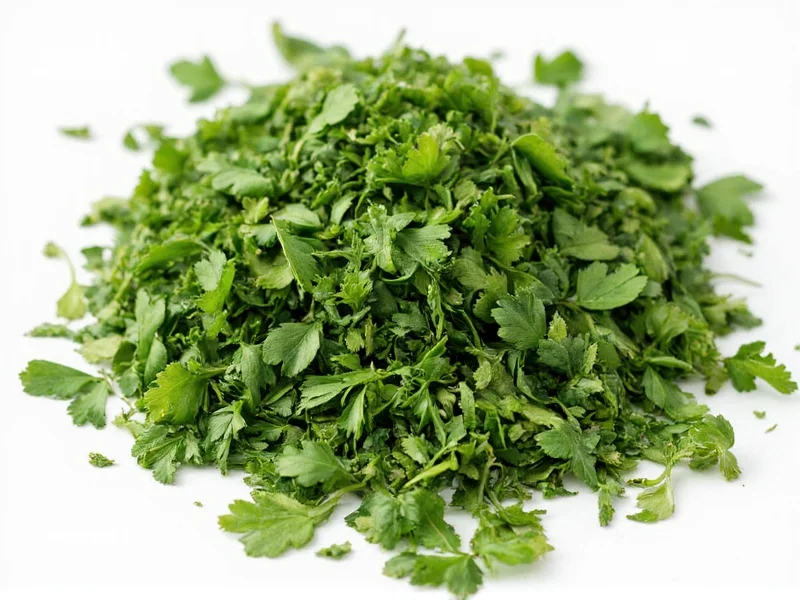Understanding Dried Parsley as a Fresh Substitute
When you're mid-recipe and realize you're out of fresh parsley, knowing how to properly substitute dried parsley becomes essential kitchen knowledge. The fundamental conversion rule—1 teaspoon dried equals 1 tablespoon fresh—stems from the dehydration process that concentrates dried herbs' flavor compounds while removing their water content.
Dried parsley typically contains about three times the flavor intensity of fresh due to this concentration effect. However, it lacks the bright, grassy notes and crisp texture that make fresh parsley valuable in finishing dishes. Understanding these differences helps you make informed substitutions that won't compromise your culinary results.
Parsley Substitution Measurement Guide
| Fresh Parsley Required | Dried Parsley Substitute | Best For |
|---|---|---|
| 1 tablespoon | 1 teaspoon | Sauces, soups, stews |
| ¼ cup | 1¼ tablespoons | Casseroles, meatloaf |
| ½ cup | 2½ tablespoons | Long-simmered dishes |
| 1 cup | ⅓ cup | Stocks, braises |
When Dried Parsley Works Best as a Substitute
Dried parsley performs admirably in cooked applications where its flavor can slowly release during the cooking process. The extended heat exposure allows dried herbs to rehydrate and distribute their flavor throughout the dish. This makes dried parsley an excellent choice for:
- Long-simmered tomato sauces and stews
- Meatloaf and meatball mixtures
- Casseroles requiring baking
- Stocks and broths
- Dry rubs for proteins
For these applications, add dried parsley early in the cooking process to maximize flavor development. Unlike fresh parsley which loses vibrancy with prolonged heat, dried parsley benefits from extended cooking time.
Limitations of Dried Parsley Substitution
Certain culinary applications simply don't translate well when substituting dried for fresh parsley. The texture and visual appeal of fresh parsley make it irreplaceable for:
- Garnishing finished dishes
- Fresh herb salads
- Persillade (chopped parsley and garlic)
- Tabbouleh and other fresh grain salads
- Chimichurri and other fresh herb sauces
In these cases, consider alternative fresh herbs like cilantro or chives if parsley isn't available, rather than using dried parsley which would create an unpleasant texture and muted flavor profile.
Maximizing Flavor When Substituting Dried for Fresh
To get the most from your dried parsley substitution, follow these professional cooking techniques:
Bloom in oil: Heat 1 teaspoon of dried parsley in 1 tablespoon of olive oil for 30-60 seconds before adding to your dish. This releases essential oils and creates a more complex flavor profile that better mimics fresh herbs.
Rehydrate first: For applications where texture matters more, mix dried parsley with a small amount of warm water or broth and let sit for 10 minutes before using. This partially restores the herb's cellular structure.
Adjust seasoning: Because dried herbs lack the natural moisture of fresh varieties, you may need to slightly increase other seasonings to maintain flavor balance in your dish.
Common Substitution Mistakes to Avoid
Many home cooks make these critical errors when substituting dried parsley for fresh:
- Using equal measurements - This results in overly strong, sometimes bitter flavors
- Adding dried parsley at the end of cooking - Unlike fresh, dried herbs need time to rehydrate and release flavor
- Using old dried parsley - Dried herbs lose potency after 6-12 months; check freshness by rubbing between fingers and smelling
- Substituting in raw applications - Dried parsley's texture is unpleasant in uncooked dishes
Remember that dried parsley has a more earthy, muted flavor profile compared to fresh's bright, grassy notes. Adjust your expectations accordingly and consider adding a squeeze of lemon at the end of cooking to brighten dishes where you've made the substitution.
Storage Tips for Maximum Freshness
Whether you're using dried or fresh parsley, proper storage affects substitution success:
- Store dried parsley in an airtight container away from light and heat
- Replace dried herbs every 6-12 months for optimal flavor
- Keep fresh parsley stems in water in the refrigerator, covered with a plastic bag
- Freeze fresh parsley in olive oil for longer storage while preserving flavor
Freshness directly impacts substitution ratios—older dried parsley may require slightly more to achieve the same flavor intensity as fresh.
Practical Substitution Scenarios
Understanding real-world applications helps solidify your dried parsley substitution knowledge:
Tomato sauce: For a recipe calling for 2 tablespoons fresh parsley, use 2 teaspoons dried. Add during the last 15 minutes of simmering to preserve flavor without bitterness.
Chicken seasoning: When making a dry rub that requires ¼ cup fresh chopped parsley, substitute 1¼ tablespoons dried. Mix with other dry spices for even distribution.
Potato salad: Avoid substituting dried for fresh in this application. The texture won't rehydrate properly in cold dishes. Consider chives or celery leaves instead.











 浙公网安备
33010002000092号
浙公网安备
33010002000092号 浙B2-20120091-4
浙B2-20120091-4